A status report on fiber access network developments that could one day displace DSL * Technologies * Deployments * Video dimension
August 8, 2005

Even as DSL becomes the globally dominant, mass-market, broadband access technology, a potential DSL-killer is steadily creeping up on the market. This is the PON – the Passive Optical Network. Video is a major aspect of PONs and a key reason why telcos, keen to get into triple-play converged services to offset collapsing POTS revenues, are beginning to turn to PONs as a way of getting fiber bandwidth to the home.
Telcos and industry pundits have been talking of mass deployment of fiber in the access network for years, of course, and a whole alphabet soup of acronyms has appeared as the number of network approaches and technologies has multiplied. Generically, they take the form of Fiber to the Something (such as Home, Premises, Building, Business, Curb, Node) – or FTTx. What’s become so interesting recently is the adoption of PONs for real FTTx rollouts and the standardization of two improved and faster PON types – Ethernet PON (EPON) and Giga PON (GPON).
So has the tide finally turned in favor of mass-market FTTx? And for which X? And for which PON technology? And, to get practical: How easy are PONs to install? And what are the options for video over PONs?This report looks at these and other aspects to give a timely update on what’s going on in the PON and FTTx world, and why telcos need to think beyond DSL in the broadband stakes. Here’s a hyperlinked contents list:
FTTx Defined
The alphabet soup of fiber access networksPON & Fiber Plant Basics
Simple idea, but it needs testingPON Activities Worldwide
The rollout begins in earnestAPON, BPON, EPON & GPON
'Pon my word, a lot of standardsVideo on PONs
What it's all about, really
Webinar
This report was previewed in a Webinar sponsored by Acterna Corp., Alcatel (NYSE: ALA; Paris: CGEP:PA), and UTStarcom Inc. (Nasdaq: UTSIE). It may be viewed free of charge in our Webinar archives by clicking here.
Related Light Reading Webinar archives
Related Heavy Reading reports
— Michael Howard, Principal Analyst and Cofounder, Infonetics Research Inc.
The X in FTTx can stand for a lot of things, often not very different, but for practical purposes they can all be grouped in any of three basic approaches:
1) Fiber all the way to the residential or business customer by using PON or Ethernet
These are:
Fiber to the Home (FTTH)
Fiber to the Building (FTTB)
The distinction is basically between single homes or apartments and business or multitenant buildings.
2) Fiber all the way to the customer by using PON only
This is:
Fiber to the Premises (FTTP)
3) Fiber partial
These all use copper from the partial point on to the customer:
Fiber to the Neighborhood (FTTN)
Fiber to the Node (also FTTN)
Fiber to the Curb (FTTC, also FTTK for those who spell, usefully, curb as kerb)
Fiber to the Cabinet (also FTTC)
Fiber partial means fiber goes to some point near to the customer, and then another mechanism (usually copper pairs supporting ADSL or VDSL) takes over for the final link to the customer.
The two FTTNs – FTTNeighborhood and FTTNode – mean basically the same thing: fiber is run out to a point close to the customers. Typically in North America this is a node in a remote terminal, or even closer to the customer in a crossconnect or similar box. The main deployments in North America for FTTN usually have a node that can handle 400 to 600 customers or homes.
FTTCabinet is pretty similar to the FTTNs, and FTTCurb refers to fiber deployments that go even closer to the customer, and usually serve eight to 24 customer drops (copper).
Figure 1 shows how some of these main varieties of FTTx are differentiated when using PON fiber. The big attractions for telcos in deploying PONs as the basis of a mass-market fiber rollout are:
The big attractions for telcos in deploying PONs as the basis of a mass-market fiber rollout are:
All-optical passive loop plant
Significantly reduced CO wiring and space requirements
Reduced plant operational expenditures
Easy upgrades and long plant life
The basic fiber-all-the-way PON (either FTTH or FTTB or FTTP) arrangement shown in Figure 2 has optical line terminals (OLTs) interfacing with the service node at the central office (CO) on the carrier side, and optical network terminals or optical network units (ONTs or ONUs) on the customer side. Instead of running a separate fiber from the OLT to every customer, a single fiber runs from the OLT towards the customers, and optical splitters drop off short runs of fiber from the main fiber to each customer.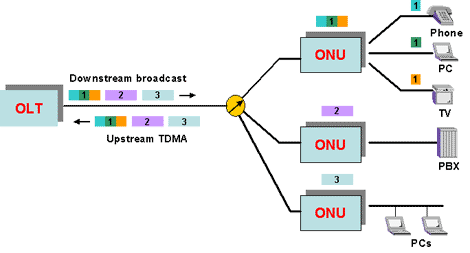 The basic architecture for communications in the PON is a point-to-multipoint network, where the OLT at the CO serves as the control point for the entire PON, and the ONU serves as the subscriber point or controlled point. Typically, a single OLT serves 32 ONUs.
The basic architecture for communications in the PON is a point-to-multipoint network, where the OLT at the CO serves as the control point for the entire PON, and the ONU serves as the subscriber point or controlled point. Typically, a single OLT serves 32 ONUs.
The splitter is a very simple device and is passive, with no electronics. It allows the downstream and upstream traffics (with respect to the OLT) to be split and combined from and onto the shared portion of the fiber. Different wavelengths are used for the two directions to avoid collisions and interactions between the downstream and upstream traffic flows.
To transmit downstream, the OLT broadcasts all the traffic to every ONU on the PON through the action of the splitters. The traffic can be framed as TDM (for T1 or other circuit-oriented traffic), or it can be encapsulated with ATM. In Ethernet PONs, the traffic is naturally packetized.
In the reverse, or upstream, direction, multiple ONUs could potentially transmit simultaneously, causing collisions and interactions among the upstream traffic flows. PONs avoid this through an arbitration protocol that controls when each ONU is allowed to transmit. Popular methods include a TDM timeslot arrangement, or a prescheduled packet-allocation or bandwidth-allocation scheme.
Protocols are now defined to provide bandwidth management, QOS, and other capabilities. The result is that the basic point-to-multipoint architecture of a PON can support point-to-point communications in the normal way.
Practicalities of PON Installation
The widescale rollout of PONs will introduce a new range of issues for installation crews handling the outside plant. Figure 3 shows a simplified installation, where three wavelengths (1310, 1490, and 1550nm) are used: two for the basic PON and one for an RF video overlay signal (a common alternative to IPTV over the basic PON). PONs are a fairly sophisticated technology, and a good testing strategy is needed for their successful deployment.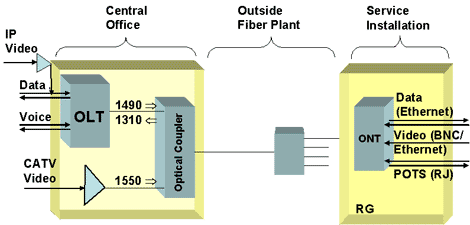 So bidirectional insertion-loss testing with a power meter and a light source, as well as bidirectional link characterization with an optical time-domain reflectometer (OTDR) is recommended for the initial fiber installation. In addition, bidirectional OLT testing is recommended if a CATV video signal is being carried on a third wavelength because of the sensitivity of the analog video transmission to interference.
So bidirectional insertion-loss testing with a power meter and a light source, as well as bidirectional link characterization with an optical time-domain reflectometer (OTDR) is recommended for the initial fiber installation. In addition, bidirectional OLT testing is recommended if a CATV video signal is being carried on a third wavelength because of the sensitivity of the analog video transmission to interference.
“We recommend that each of these tests is performed at 1310, 1490, and 1550 nanometers,” says Jim Nerschook, telecom field service VP for Acterna Corp. “If the system is only deploying IP video, the optical testing at 1310 and 1400nm is sufficient. If you performing these tests on an installation, it is highly recommended that these tests be conducted on a section-by-section basis while the plant is being installed. This is going to greatly assist the installation crews in identifying the trouble spots in the network.”
Critical testing in a CO is power-level testing at the three wavelengths present at the OLT. Additionally at this point, the incoming video should be characterized to ensure proper performance when delivered into the network.
The range of tests becomes most extensive at the customer’s end of the PON, as it covers both the Physical Layer testing and the service testing.
For fiber testing, it is critical to validate that the various wavelengths coming down to the ONT/ONU or residential gateway are within specification. In a downstream structure where RF video is coupled on, there are two downstream wavelengths, and neither should be below the generally accepted –0dB. Once that has been validated, the residential gateway device would be installed.
At this point, some test methods include validation of the upstream wavelength (1310nm) at that point. Importantly, the dropside or customer-facing service interfaces should be tested as well. So, for example, ISP connectivity should be validated, and throughput tests might be performed to validate the actual data throughput to customers.
If RF video is deployed, there are critical parameters that must also be tested at the coax interface. These include average digital power level, modulation error ratio (MER), bit error rate, and, potentially, an analysis of the constellation diagram – although that might be considered more of a troubleshooting scenario.
If IP video service is deployed, service-access validation is essential to show that a broadcast video stream or a VOD program can be obtained. This can be done by using an emulation of IGMP (Internet Group Management Protocol) for broadcast video or of RTSP (Real-Time Streaming Protocol) for VOD.
Once the critical video flows have been established, it is important to analyze things such as packet loss and jitter, the program clock reference signal, and the PID (program identification) mapping of programmed data to the channel map.
“While obviously the Physical Layer portion of the installation should be validated, it is equally important to make sure that the services – voice, video, and data – are functioning correctly,” says Acterna’s Nerschook. “Voice could be VOIP or just POTS at that point, but, in either case, that should be validated as well.”
For broadband users, 1- or 2-Mbit/s has become fairly standard, either via cable or DSL. The big attraction of the PON is that it can go much higher – up to 100-Mbit/s per subscriber, depending on the number of shared users on the PON. So, basically, a PON gives a way of servicing broadband for perhaps 10 or more years ahead (see Figure 4).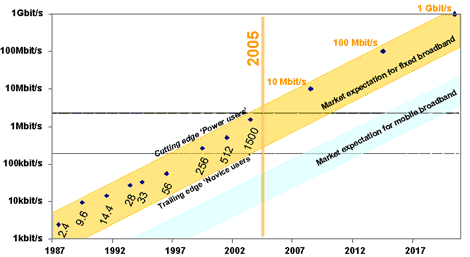 PON-based FTTP is already being rolled out, but at different rates and with technological variations, in different parts of the world. The main regions currently are Asia/Pacific, North America and, to some extent, Europe; there is little deployment activity in Latin America, for example, although Teléfonos de México (Telmex) is evaluating FTTP in Mexico, and other operators are making early evaluations.
PON-based FTTP is already being rolled out, but at different rates and with technological variations, in different parts of the world. The main regions currently are Asia/Pacific, North America and, to some extent, Europe; there is little deployment activity in Latin America, for example, although Teléfonos de México (Telmex) is evaluating FTTP in Mexico, and other operators are making early evaluations.
Asia/Pacific
Japan is where the real FTTP action is happening, largely because the government has policies that help encourage broadband use, and because there is a lot of competition there.
NTT Group (NYSE: NTT) (NTT West) is rolling out Ethernet PONs (EPONs) into the mass market and had reached 1.7 million customers by fall 2004. In early 2005, NTT (East and West) started deploying EPON (actually called GigE PON in Asia, or GEPON). Alternative carriers, such as Softbank's Yahoo! Broadband, are committed to similar large-scale rollouts. NTT announced in late 2004 a long/medium-range plan under which it is to spend $48 billion to reach 30 million subscribers with PON and EPON by 2010.
Other parts of Asia/Pacific – such as China, Korea, and Australia – are in the early stages of FTTP deployment. Overall, Asia/Pacific accounted for 93 percent of the world’s 1.4 million PON subscribers in 2004.
North America
In North America there were about 150,000 FTTP subscribers and a million homes passed by late 2004. These are mostly deployments by the small operators. However, both Verizon Communications Inc. (NYSE: VZ) and SBC Communications Inc. (NYSE: SBC) are deploying PONs and have appointed vendors for their initial deployments. Verizon has plans to pass three million premises by the end of 2005. SBC had field trials during 2004 and plans, starting in 2005, to deploy PONs to 300,000 homes a year.
North America accounted for just 6 percent of total PON subscribers in 2004, but Infonetics Research Inc. expects this will grow to 23 percent by 2008.
Europe
In Europe there is a considerable early FTTP deployment (about 400,000 FTTP subscribers in 2003, for example, mostly by CLECs), but it is mostly Ethernet, not PONs, and is moving only slowly in the PON direction. FastWeb SpA in Italy had about 130,000 subscribers by late 2004; Bredbandsbolaget AB (B2) in Sweden had about 100,000. The former PTTs have triple-play plans (though not necessarily involving fiber), and there is also growing interest in FTTP from smaller or underserved communities.
Market growth
Overall, Infonetics expects the number of PON subscribers worldwide to reach 22 million in 2008. As a result, the market for PON hardware is forecast to grow sharply. Worldwide OLT and ONT PON equipment revenue reached $525 million in 2004 and is projected to grow to $2.2 billion in 2008, with port shipments reaching more than 8 million, according to Infonetics' biannual market share and forecast report, PON Equipment.
There are several different PON standards – and a corresponding alphabet soup of acronyms – as a result of the continuing evolution of PON technologies over the last 20 years or so. The formation of the Full Service Access Network (FSAN) Group in the mid-1990s gave much of the impetus to the development of standards suitable for mass-market deployment.
The first PON standard was APON (ATM PON), which used ATM encapsulation of the transported data and was aimed primarily at business applications. APON was quickly followed by BPON.
BPON (Broadband PON) is the form of PON being almost exclusively rolled out today. It has largely replaced APON in PON deployments because of its superior features. For example, it has survivability, WDM support for video overlay, higher upstream bandwidths, and dynamic upstream bandwidth allocation, which APON does not. BPON can be run at 622 Mbit/s or 1.2 Gbit/s.
EPON (Ethernet PON) was standardized in mid-2004 and is the Institute of Electrical and Electronics Engineers Inc. (IEEE) Ethernet in the First Mile (EFM) standard. It runs at 1.25 Gbit/s symmetric and is suitable for data services. And, of course, it uses Ethernet rather than ATM data encapsulation.
“IP to the home will be impacted almost completely by the cost/performance equation,” says Bill Huang, senior VP and chief technology oficer of UTStarcom Inc. (Nasdaq: UTSIE). “The idea of EFM was to combine Ethernet and PON technologies to provide a most cost-effective and high-performance access technology. Since the architecture combines the point-to-multipoint technology inherent in the original Ethernet technology (based on coaxial cable), it was a straightforward adaptation of Ethernet through the PON, and it became commercially viable very quickly after the ratification of the standard.”
GPON (Gigabit PON) is under development by the same ITU and FSAN groups that developed BPON, and there are a couple of suppliers delivering early versions of GPON today. It looks as if North America, where there is a lot of BPON being rolled out, will favor GPON, because it is an evolution of BPON. GPON will support Ethernet in addition to ATM for the Layer 2 data encapsulation, and it will offer enhanced security.
“GPON is really the continuation of the work done for BPON by the FSAN Group,” says Sayeed Rashid, senior manager of marketing at Alcatel (NYSE: ALA; Paris: CGEP:PA), Access Network Division, North America. “The specifications are really based on the premise that efficient IP transport and bandwidth scaleability are key for the PON in the future. In GPON you have twice the bandwidth scaleability – up to 2.5 Gbit/s symmetric – that you have in the other PONs. With GPON you also have highly efficient IP transport capability compared to other PONs.”
The introduction of the ONT management and control interface (OMCI) specification, adopted in April 2004, largely completes the work for the basic set of GPON specifications. So standards-compliant products should start appearing in 2005, and mass-market deployment should begin in 2006.
Table 1 compares the three main types of PON.
{Table 1}In the market, the battle between BPON and EPON continues, with BPON making up 84 percent of all PON subscribers in Asia in 2004. However, EPON is being rolled out so fast in market-leading Japan that it will overtake Japan’s BPON subscriber base in 2005. NTT East and NTT West together have more than a million subscribers – more than two thirds of the world’s PON subscribers – and these providers are now switching to Gigabit Ethernet PON (GEPON, a form of EPON) almost exclusively.
BPON is the PON technology gorilla in North America, making up 81 percent of North American PON revenue in 2004, and will continue its reign through 2006, when its successor, GPON, becomes more available. GPON is a flexible option for providers because it is designed to handle Ethernet, IP, and ATM traffic, and can stream video over IP or a separate analog wavelength. GPON offers roughly twice the capacity of EPON.
EPON is firmly entrenched in much of Asia, but GPON is gaining momentum in North America, Europe, and several Asian countries, with China a good possibility, where analog video is an issue. By 2008, North America will account for 43 percent of worldwide PON revenue (where GPON dominates), and Asia will account for 39 percent of worldwide revenue (where EPON dominates).
Video, as the telcos’ missing part of triple-play consumer plans, is a key reason for the growing interest in PONs. There are two ways of delivering video over a PON:
Radio frequency (RF) overlay
IP video (or IPTV)
Some telcos will do both – others will do only one of the options.
RF Overlay
RF overlay produces a network capable of supporting all types of video services:
Analog broadcast
Digital broadcast and HDTV
Video on demand (VOD)
The advantage of this model is that it exploits the existing economies of scale in the cable industry, and offers a full suite of services without needing any changes in the home network or any rewiring in the home. So, for the customer, the telco looks very much like a normal cable company. Figure 5 shows a typical setup.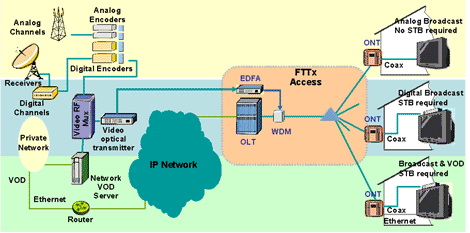 This model use an RF headend, similar to that in a cable MSO network. The video signal is transported by a separate fiber network to the CO, where an EDFA amplifies the signal and puts it on a separate dedicated wavelength (1550nm). A video coupler then combines this with the data traffic from the CO OLT, which uses a different wavelength (1490nm), putting both wavelengths on the same fiber PON and distributing them downstream through the splitters to the customer ONT/ONUs.
This model use an RF headend, similar to that in a cable MSO network. The video signal is transported by a separate fiber network to the CO, where an EDFA amplifies the signal and puts it on a separate dedicated wavelength (1550nm). A video coupler then combines this with the data traffic from the CO OLT, which uses a different wavelength (1490nm), putting both wavelengths on the same fiber PON and distributing them downstream through the splitters to the customer ONT/ONUs.
The ONT separates the wavelengths for video and data by using a device called a triplexer, which is typically integrated into the ONT. For analogue video, the video signal can be sent directly via coax to the TV (so no set-top box); for digital channels and services, and VOD, there has to be a set-top box to decode the signals. Upstream control channels are needed to control the channel. A return upstream control channel is needed for video selection and so forth, and this is commonly provided by using RF signaling over the home coax to the ONT/ONU, which then converts it to Ethernet for transmission over the 1310nm data upstream wavelength, and thence via an IP connection back to the headend.
IP Video
Despite the initial attractions of RF overlay, IP video probably offers telcos the best long-term solution for video and a source of potential competitive advantages against cable MSOs. The key point is that data and video use the same IP transport mechanism and travel over the same network and wavelength to the customer. Figure 6 shows a typical setup.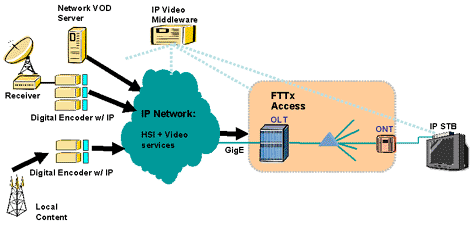 In this model, there is an IP headend, where the video signal is converted into IP data streams. At the home, there is an IP set-top box, which converts the IP data stream back into a video signal that feeds the TV.
In this model, there is an IP headend, where the video signal is converted into IP data streams. At the home, there is an IP set-top box, which converts the IP data stream back into a video signal that feeds the TV.
“If you are doing IP video services for DSL networks, which is typical for telcos at this point because RF overlay is not an option for copper, IP video is your only choice if you want to move to fiber,” says Alcatel’s Rashid. “You want to have a single network serving both types of customer – customers off DSL networks as well as customers off fiber access networks. Also, converging multiple services like video and data can produce value-added features that are generally not possible for cable networks, giving you a comparative advantage when you offer IP video as opposed to RF.”
Bandwidth Issues
Superficially, it might seem that there could be a bandwidth problem with bandwidth-hungry video over PONs because of the high level of splitting (1:32 or 1:64) downstream: If all 32 homes on a PON eventually subscribe to video, for example, could the capacity of the main fiber be exhausted, given that it is carrying data (and voice) as well? The last thing a telco wants is to have to reengineer the fiber plant because of capacity constraints – the very thing fiber is supposed to eliminate.
Fortunately, the answer should be "no." To start with, the RF-overlay approach is inherently immune to the problem because the video is carried on a separate wavelength from the data services, so there is no capacity interaction between the two. In principle, there could be a problem with IP video, since it shares the same wavelength and IP channel as the data traffic, but there are mitigating factors:
In many cases, a lot of the video traffic will be broadcast traffic, so even though it is split 32 times, for example, it does not necessarily consume 32 times the amount of bandwidth on the main fiber, because several customers may be viewing the same broadcast. So there is likely to be some statistical bandwidth gain.
The PON itself is scaleable. So the telco can start, say, with BPON today, and, using the same outside plant, can upgrade the OLT cards to EPON or GPON to obtain additional bandwidth when needed to support high levels of video traffic.
Video-compression technology is becoming very effective. For example, the downlink for EPON is 1 Gbit/s for pure traffic. On a point-to-point basis for a 1:32 split, this gives about 30 Mbit/s per household. A modern, low-bit-rate, high-quality codec for H.264, MPEG4, AVC, or Windows Media 9 uses about 2 Mbit/s of traffic for broadcast-quality video and 6 Mbit/s for high-definition video. So 30 Mbit/s will easily support a multi-TV/multi-PC household.
PON IP Video Business Case
The big bugaboo of mass-market (and necessarily new-build) FTTx is the business case. Figure 7 and Table 2 show how IP video using PONs is playing the business case in Japan for one of its current rollouts. {Table 2}From the CO a fiber is generally split 1:4. This is for the future: The fourth split can be attached to a direct PON in the future if this becomes needed or wanted. Initially, it gives a lower concentration ratio to allow the network to reach more locations by using fewer OLTs. At the remote site, which is generally at the curbside, the fiber is split 1:8, and so can reach eight homes.
{Table 2}From the CO a fiber is generally split 1:4. This is for the future: The fourth split can be attached to a direct PON in the future if this becomes needed or wanted. Initially, it gives a lower concentration ratio to allow the network to reach more locations by using fewer OLTs. At the remote site, which is generally at the curbside, the fiber is split 1:8, and so can reach eight homes.
As Table 2 shows, for this infrastructure build-out, the total fixed cost is generally about $750 per subscriber. The infrastructure cost for the OLT and ONU combined is basically $200 in the volume of one million to five million subscribers. The set-top box is generally about $150 with relatively high-quality video, such as Windows Media 9 and H.264-type video codecs. There is a small recurring cost depending on the type of carrier involved.
The revenue model has basic and optional services. Optional services could include roaming WLAN services, VOIP, and IPTV. Revenue from optional services is estimated at $50 per month.
“That is where the growth is,” says UTStarcom’s Huang. “If you add in additional costs (such as marketing), payback on investment will be around a year or less. And that, I think, is where the compelling value of doing a complete, IP-based, triple-play network is. If you want to do an RF overlay, that would add a significant additional cost, but in this case you don’t need to do that.”
You May Also Like









